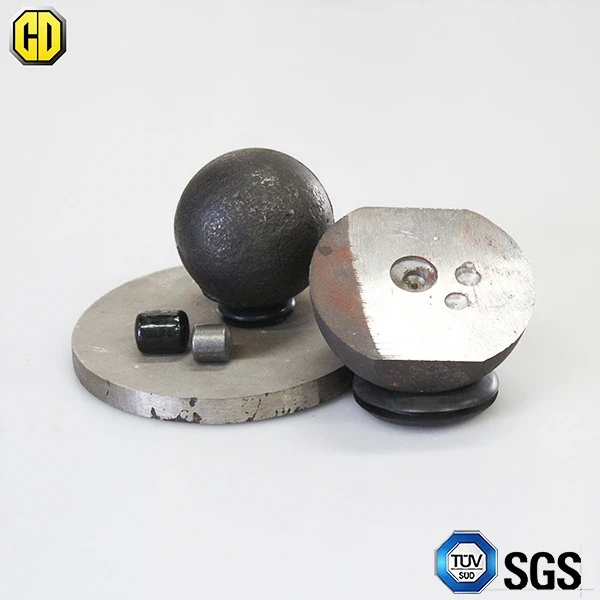Nov . 06, 2025 14:35 Back to list
High Chrome Grinding Media | Wear-Resistant, Low Breakage
What’s Changing in High Chrome Grinding Media: Field Notes from the Mill Floor
If you’ve spent time around mills (I have, dusty boots and all), you know wear cost is the quiet line item that eats budgets. Lately, plants are leaning harder on High Chrome Grinding Media to push throughput and bring down cost per ton. Not hype—just a gradual, measurable shift driven by harder chemistries, better heat-treatment windows, and smarter QC.

Product snapshot (real-world ready)
Product: High Chrome Grinding Ball (cast). Origin: KIZUN Industry Zone, Luquan, Sihijiazhuang city, Hebei, China. Size range: 10–140 mm. Chrome content: ≈10–28% (Cu, Mo, Ni micro-alloys as needed). Color: black as-cast, often tempered hue after heat treatment. Used across cement, mining, power, chemicals, petroleum, and refractory grinding lines.
| Parameter | Typical Range | Notes |
|---|---|---|
| Chromium (Cr) | ≈10–28% | High-Cr white iron per ASTM A532 families [1] |
| Hardness (HRC) | ≈58–66 HRC | Brinell/Rockwell checked per ASTM E10/E18 [2] |
| Core/Microstructure | M7C3 carbides in martensitic matrix | Balanced abrasion + impact resistance |
| Diameter Tolerance | ±0.8–1.5 mm (typ.) | Real-world use may vary with size |
| Service Life | ≈1.5–3× vs low-Cr media | Ore abrasiveness and mill load matter |
How it’s made (the short shop-floor version)
- Materials: High-Cr white iron charge + ferroalloys; low-S, low-P base for cleanliness.
- Methods: Precision casting (metal molds or sand), controlled solidification to avoid porosity; quench + temper to dial toughness.
- QC & testing: Hardness per ASTM E10/E18; microstructure verification (etched sections); drop-weight impact; UT/VT for defects; size/roundness checks.
- Standards & systems: Chemistry aligned to ASTM A532; plants typically run ISO 9001 quality systems [1][3].
Where it shines
- Cement finish mills chasing lower specific power; - Gold/copper concentrators reducing media make-up rate; - Coal and petcoke grinding where contamination control matters. Many customers say the biggest surprise is steadier size distribution over time—less “flat-spot” drama.
Vendor landscape (field comparison)
| Vendor | Chrome Range | Heat Treatment | Typical Edge |
|---|---|---|---|
| Hebei-based producer (KIZUN, Luquan) | ≈10–28% | Quench + temper, batch verified | Aggressive pricing, flexible sizes (10–140 mm) |
| Multinational A | ≈12–26% | Continuous heat-treatment line | Global stocking, process audits |
| Regional Foundry B | ≈10–18% | Localized recipes | Fast lead times, custom small batches |
Note: Specs above are indicative; always review mill conditions and vendor cert packs.
Customization that actually matters
Dialing carbides to your ore is the trick. For high-impact SAG environments, temper toward toughness; for abrasive fine grinding, push higher Cr with tighter quench. Sizes from 10–140 mm cover regrind up to primary. Some plants ask for lower residuals (Pb, As) for product purity—fair ask, check melt shop controls.
Two quick case notes
- Cement (SE Asia): Switched to High Chrome Grinding Media in a 2-chamber mill; media make-up rate down ≈18%, kWh/t trimmed by ~3%—mostly from steadier classification.
- Gold (Andes): Coarser ore phase; moved to 20–22% Cr balls, tempered higher. Liner life flat, but ball consumption down ≈22% over 90 days. Operations liked the more predictable wear curve.
What buyers check (and you should too)
- Certificates: Mill test report (chem + hardness), heat-treatment charts; ISO 9001 QMS [3].
- Test data: Drop tests, retained austenite checks, UT/VT defect rates.
- Logistics: Batch traceability and size segregation—surprisingly common pain point.
Final thought: there’s no magic bullet media, but well-made High Chrome Grinding Media does two things reliably—stabilizes grind and lowers consumption. In practice, that’s what keeps the plant manager’s phone quiet. Which is nice.
References
- ASTM A532/A532M – Standard Specification for Abrasion-Resistant Cast Irons. ASTM International. https://www.astm.org/a0532_a0532m-10r19.html
- ASTM E10 – Standard Test Method for Brinell Hardness of Metallic Materials. ASTM International. https://www.astm.org/e0010-18.html
- ISO 9001:2015 – Quality management systems — Requirements. International Organization for Standardization. https://www.iso.org/standard/62085.html
-
Expert Insights on Fabrica de Molinos de Bolas: Industry Trends & Global Applications
NewsNov.24,2025
-
Expert Insights on Fabricantes de Bolas de Molienda de Acero: Global Applications & Trends
NewsNov.23,2025
-
Leading Fabricantes de Bolas de Molienda: Your Ultimate Guide to Grinding Balls
NewsNov.23,2025
-
Fabricante de Bolas de Molienda – Quality Grinding Balls for Efficient Industry
NewsNov.23,2025
-
Trusted Proveedores de Medios de Molienda for Efficient Industrial Grinding
NewsNov.22,2025
-
Proveedores de Bolas de Molienda: Your Guide to Top Grinding Ball Suppliers & Industry Insights
NewsNov.22,2025
Realted Products
















